CBSE Previous Year Question Papers Class 12 Economics 2018
Time allowed : 3 hours
Maximum marks: 80
General Instructions:
- All question in both sections are compulsory.
- Marks for questions are indicated against each questions.
- Question Nos. 1-4 and 13-16 are very short-answer questions carrying 1 marks each. They are required to be answered in one sentence each.
- Question Nos. 5-6 and 17-18 are short- answer questions carrying 3 marks each. Answer to them should normally not exceed 60 words each.
- Question No. 7-9 and 19-21 are also short-answer questions carrying 4 marks each. Answer to them should normally not exceed 70 words each.
- Question Nos. 10-12 and 22-24 are long- answer questions carrying 6 marks each. Answer to them should normally not exceed 100 words each.
- Answer should be brief and to the point and the above words limits should be adhered to as far as possible.
CBSE Previous Year Question Papers Class 12 Economics 2018
SECTION — A
Question 1.
When the total fixed cost of producing 100 units is ₹ 30 and the average variable cost ₹ 3, total cost is : (Choose the correct alternative) [1]
(a) ₹ 3
(b) ₹ 30
(c) ₹ 270
(d) ₹ 330
Answer:
(d) ₹ 330.
Question 2.
When the Average Product (AP) is maximum, the Marginal Product (MP) is : (Choose the correct alternative) [1]
(a) Equal to AP
(b) Less than AP
(c) More than AP
(d) Can be any one of the above
Answer:
(a) Equal to AP
Question 3.
State one example of positive economics. [1]
Answer:
Increasing the interest rate to encourage people to save is an example of positive economics.
Question 4.
Define fixed cost. [1]
Answer:
Fixed costs are those costs which do not vary with the level of output. For e.g. Rent of factory.
Question 5.
Explain the central problem of “choice of technique”.
OR
Explain the central problem of “for whom to produce”. [3]
Answer:
The problem of “choice of technique” is the second major central problem faced by the economy ever. Basically, there are two choices of techniques i.e.,
- Capital-intensive technique: This is the technique, in which capital is required more than the labour.
- Labour-intensive technique: This is the technique in which labour is required more than the capital.
OR
An economy faces a major central problem
i. e., for whom the production is to be done? Production/Income is distributed either on the basis of the purchasing powers of the consumers or on the basis of requirements of the individuals.
Two types of distribution are:
- Functional Distribution
- Personal Distribution.
Question 6.
What is meant by inelastic demand ? Compare it with perfectly inelastic demand. [3]
Answer:
Elasticity is a measure of the responsiveness of the quantity demanded to a change in its price. Inelastic demand means that the demand for a product does not increase or decrease corresponding to the fall or rise in its price. In this case elasticity is less than 1, as percentage change in quantity demanded is less than the percentage change in price.
For Ex.—Percentage change in quantity demanded is 10%
whereas percentage change in price = 20%
So, Elasticity (Ed < 1) = 0.5
On the other hand, when increase or decrease in price does not affect the quantity demanded, it is known as perfectly inelastic demand.
For Ex.—Price is changed by 10% but quantity demanded remains the same i.e.,
Percentage change in quantity demand = 0
Percentage change in price = 20%
So, elasticity is 0.
Question 7.
When the price of a commodity changes from ? 4 per unit to ? 5 per unit, its market supply rises from 100 units to 120 units. Calculate the price elasticity of supply. Give reason. [4]
Answer:
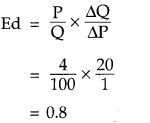
It is inelastic, as elasticity is less than one.
Question 8.
What is meant by price ceiling? Explain its implications. [4]
Answer:
Price ceiling is a situation when the price charged is more than or less than the equilibrium price determined by market forces of demand and supply. It has been found that higher price ceilings are ineffective. Price ceiling has been found to be of great importance in the house rent market.
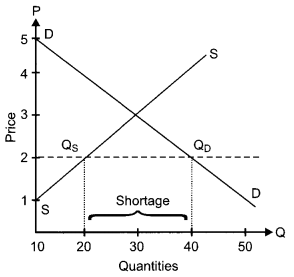
Implications of Trice Ceiling’
- Price ceiling enables the availability of basic goods at reasonable price to the poor. This enables to increase the welfare of the people.
- When there is a fall in the price level, the demand for a good increases more than the supply of the good. Hence, it creates an excess demand for the good.
Question 9.
Given the price of a good, how will a consumer decide as to how much quantity to buy of that good ? Explain.
OR
What is Indifference Curve? State three properties of indifference curves. [4]
Answer:
Consumer equilibrium refers to the situation when consumer gets maximum satisfaction/utility from the goods it consumes. It is the situation through which a consumer decides how many units of the goods to consume.
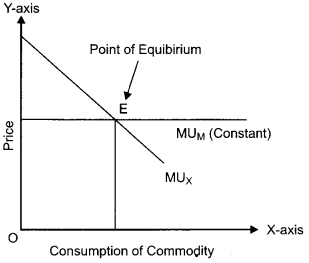
Price remains constant when MU of goods is more than its price, and it that case, consumer will decide not to purchase that good.
Also, when MU is less than its price, then also consumer will give up its consumptions. As a consumer will consume only when, MU is equal to price.
MUx = Px
In the figure,
X-axis = Consumption
Y-axis = Price
E = Consumer Equilibrium
OR
A curve on a graph (the axis of which represent quantities of two commodities) linking those combinations of quantities which the consumer regards as of equal value.
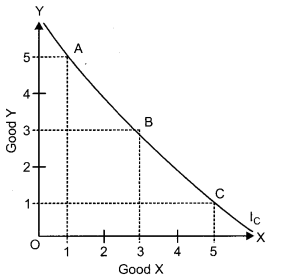
IC—Indifference Curve.
X-axis = Goodx
Y-axis’= Goody
Properties:
- Higher IC gives higher level of satisfaction.
- Two Indifference curves never intersect each other.
- Indifference curve is convex to the origin.
Question 10.
State three characteristics of monopolistic competition. Which of the characteristics separates it from perfect competition and why ?
OR
Explain the implications of the following :
(a) Freedom of entry and exit of firms under perfect competition.
(b) Non-price competition under oligopoly. [6]
Answer:
The main features of monopolistic competition are as under:
(1) Large Number of Buyers and Sellers : There are large numbers of firms but not as large as under perfect competition. That means each firm can control its price- output policy to some extent. It is assumed that any price-output policy of a firm will not get reaction from other firms so each firm follows the independent price policy.
(2) Less Mobility : Under monopolistic competition, both the factors of production as well as goods and services are not perfectly mobile.
(3) More Elastic Demand: Under monopolistic competition, demand curve is more elastic. In order to sell more, the firms must reduce its price.
The characteristics which separates monopo¬listic competition from perfect competition are :
(1) Nature of Firms: Under perfect competition, an industry consists of a large number of firms. Each firm in the industry has a very little share in the total output. The firms have to accept the price determined by the industry. On the other hand, under monopolistic competition the number of firms is limited. The firms can influence the market price by their individual actions.
(2) Nature of Price and Output: Under perfect competition, price is equal to marginal cost as well as marginal revenue whereas under imperfect competition it is not so. Although, under monopolistic competition marginal cost and marginal revenue are equal yet not equalising the price.
(3) Nature of Product: Under perfect competition, firms produce homogeneous products. The cross elasticity of demand among the goods is infinite. Under imperfect competition, all the firms produce differentiated products and the cross elasticity of demand among them is very small.
OR
(a) Freedom of entry and exit of firms under perfect competition : There is freedom of entry and exit of firms in perfect competition. This implies that under perfect competition, in long-run, firms earn only normal profits, so new firms does not enter or exit the market in long-run. The firms in this competition do not earn supernormal profits or losses in long-run. It is only in short-run that the firms enter or exit the market.
(b) Non-price competition under oligopoly: In an oligopoly market, firms do not compete with each other for changes in the price. If the firm increases the price, rival firms may not increase it, so it will lead to a loss of the market. Consumers will shift to rival firms. On the other hand, if the firm decreases the price, the rival firms may decrease it, so it will lead to a loss of total revenue. There will not be an increase in the demand for the product. They take into consideration the decisions of rival firms, and hence, the price does not move freely and it leads to non-price competition. High selling cost prevails in the market, resources are not fully used and welfare is not maximised.
Question 11.
Explain the conditions of consumer’s equilibrium using Indifference Curve Analysis. [6]
Answer:
According to indifference curve analysis, a consumer attains equilibrium at a point where budget line is tangent to an indifference curve. Consumer equilibrium is achieved where slope of indifference curve (MRS) = slope of budget line (Px/Py).
MRS = Px ÷ Py (Ratio of prices of two goods) Given the indifference map (preference schedule) of the consumer and budget or price line, we can find out the combination which gives the consumer maximum satisfaction. The aim of the consumer is to obtain highest combination on his indifference map and for this, he tries to go to the highest indifference curve with his given budget line. He would be in equilibrium only at such point which is common between a budget line and the highest attainable indifference curve. A consumer is in equilibrium at a point where budget line is tangent to indifference curve. At this point, slope of indifference curve (called MRS) is equal to slope of budget line.
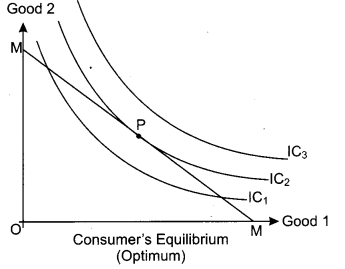
In the above fig, P is the equilibrium point at which budget line M just touches the highest attainable indifference curve IC
2
within consumer budget. Combinations on IC
3
are not affordable because his income does not permit whereas combinations on IC
1
gives lower satisfaction than IC
2
. Hence, best combination is at point P where budget line is tangent to the indifference curve IC
2
. It is at this point that consumer attains the maximum satisfaction at the state of equilibrium.
For consumer’s equilibrium, two conditions are necessary:
(a) Budget line should be tangent to indifference curve (MRS = Px/Py).
(b) Indifference curve should be convex to the point of origin (i.e., MRS should be diminishing at a point of equilibrium.)
Question 12.
Explain the conditions of producer’s equilibrium in terms of marginal revenue and marginal cost. [6]
Answer:
Producer’s equilibrium refers to the state in which a producer earns his maximum profit or minimise its losses. According to MR- MC approach, the producer is at equilibrium, when the Marginal Revenue (MR) is equal to the Marginal Cost (MC) and Marginal Cost curve cuts the Marginal Revenve curve from below.
Two conditions under this approach are :
(i) MR = MC
(ii) MC curve should cut the MR curve from below, or MC should be rising.
MR is the addition to TR from the sale of one more unit of output and MC is the addition to TC for increasing the production by one unit. In order to maximise profits, firms compare its MR with its MC.
As long as the addition to revenue is greater than the addition to cost, it is profitable for a firm to continue producing more units of output. In the diagram, output is shown on the X-axis, revenue and cost on the Y-axis. The Marginal Cost (MC) curve is U-shaped and P = MR = AR, is a horizontal line parallel to X-axis.
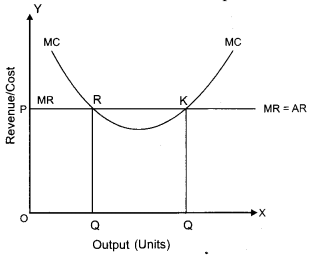
MC = MR at two points R and K in the diagram, but profits are maximised at point K, corresponding to OQ level of output. Between OQ and Q
1
levels of output, MR exceeds MC. Therefore, firm will not stop at point R but will continue to produce to take advantage of additional profit. Thus, equilibrium will be at point K, where both the conditions are satisfied.
Situation beyond OQ
1
level:
MR < MC when output level is more than OQ
1
MR < MC, which implies that firm is making a loss on its last unit of output. Hence, in order to maximise profit a rational producer decreases output as long as MC > MR. Thus, the firm moves towards producing OQ units of output.
SECTION—B
Question 13.
Define money supply. [1]
Answer:
Money supply is the total amont of money in circulation or in existence in a country at a specific time.
Question 14.
Which of the following affects national income? (Choose the correct alternative) [1]
(a) Goods and Services tax
(b) Corporation tax
(c) Subsidies
(d) None of the above
Answer:
(c) Subsides
Question 15.
Why does the consumption curve not start from the origin? [1]
Answer:
As consumption includes autonomous consumption and autonomous consumption can never be zero.
Question 16.
The central bank can increase the availability of credit by: (Choose the correct alternative).[1]
(a) Raising the repo rate
(b) Raising reverse repo rate
(c) Buying government securities
(d) Selling government securities
Answer:
(c) Buying government securities.
Question 17.
Given nominal income, how can we find real income? Explain.
OR
Which among the following are final goods and which are intermediate goods ? Give reasons. [3]
(a) Milk purchased by a tea stall
(b) Bus purchased by a school
(c) Juice purchased by a student from the school canteen
Answer:
Real income can be calculated by applying the following formula:
Real Income = \(\frac{\text { Nominal Income }}{\text { Price Index of current year }}\) × Price Index of base year
Consider price index of base year as 100 When nominal income is given, we can convert it into real income with the help of GDP deflator.
∴ Real Income = \(\frac{\text { Nominal Income }}{\text { GDP deflator }}\) × 100
OR
(a) It is an intermediate good because it is used by producer during production process of making tea and not for final consumption.
(b) It is a final good as, it is purchased by school for final consumption.
(c) It is a final good as, it is purchased by a student for final consumption.
Question 18.
Define multiplier. What is the relation between marginal propensity to consume and multiplier ? Calculate the marginal propensity to consume if the value of multiplier is 4. [3]
Answer:
In economics, a multiplier is the factor by which gains in total output are greater than the change in spending that caused it. It is usually used in reference to the relationship between investment and total national income.
Relationship between marginal propensity to consume and multiplier
There is a direct relationship between MPC and Multiplier as, the higher the MPC, the higher the multiplier and vice versa.
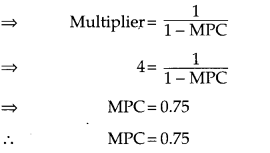
Question 19.
What is meant by inflationary gap? State three measures to reduce this gap.
OR
What is meant by aggregate demand ? State its components. [4]
Answer:
An inflationary gap, is the amount by which the actual gross domestic product exceeds the potential full-employment GDP. Three measures to reduce this gap are:
1. Fiscal Policy: Fiscal policy is the expenditure and revenue (taxation) policy of the government to accomplish the desired objectives.
In case of excess demand (when current demand is more than aggregate supply at full employment), the objective of fiscal policy is to reduce aggregate demand.
2. Monetary Policy: Monetary policy of the central bank of a country is to control the money supply and credit in the economy. Therefore, it is also called Central Bank’s Credit Control Policy. Money broadly refers to currency notes and coins whereas credit generally means loans, i.e., finance provided to others at a certain rate of interest. Monetary measures (instruments) affect the cost of credit (i.e., rate of interest) and availability of credit. Thus, it helps in checking excess demand when credit availability is restricted and credit is made costlier.
3. Miscellaneous: Other anti-inflationary measures are import promotion, wage freeze, control and blocking of liquid assets, compulsory savings scheme for households, increase in production by utilising idle capacities, etc.
OR
Aggregate demand (AD) or Domestic Final demand (DFD) is the total demand for final goods and services in an economy at a given time. It specifies the amount of goods and services that will be purchased at all possible price levels.
Components of aggregate demand are:
AD = C + I + G + (x + m)
Where
C = Consumption
I = Investment
G = Government Spending
X – M = Net Exports
1. Consumption: This is made by households, and sometimes consumption accounts for the larger portion of aggregate demand. An increase in consumption shifts the AD curve to the right.
2. Investment: Investment, second of the four components of aggregate demand, refers to the spending by firms not households. However, investment is also the most volatile component of AD. An increase in investment shifts AD to the right in the short rim and helps to improve the quality and quantity of factors of production in the long run.
3. Government: Government spending forms a large total of aggregate damand, and an increase in government spending shifts aggregate demand to the right. This spending is categorized into transfer payments and capital spending. Transfer payments include pensions and unemployment benefits and capital spending is on things like roads, schools and hospitals. Government spends to increase the consumption of health services, education and to redistribute income. They may also spend to increase aggregate demand.
4. Net Exports: Imports are foreign goods bought by consumers domestically, and exports are domestic goods bought abroad. Net exports is the difference between exports and imports, and this component can be net imports too if imports are greater than exports. An increase in net exports shifts aggregates demand to the right. The exchange rate and trade policy affects net exports.
Question 20.
The value of marginal propensity to consume is 0.6 and initial income in the economy is ₹ 100 crores. Prepare a schedule showing Income, Consumption and Saving. Also show the equilibrium level of income by assuming autonomous investment of ₹ 80 crores. [4]
Answer:
Given that,
Marginal propensity to consume (MPC) = 0.6
Initial income = ₹ 100 crores
Autonomous investment = ₹ 80 crores
C = \(\overline{\mathrm{C}}\) + c(Y)
C = 0 + 0.6(Y)
| Income (₹) | Consumption | Saving (₹) (1-MPC = MPS) MPS = 0.40 | Investment |
| 100 | 60 | 40 | 80 |
| 200 | 120 | 80 | 80 |
| 300 | 180 | 120 | 80 |
| 400 | 240 | 160 | 80 |
| 500 | 300 | 200 | 80 |
Aggregate Demand (AD) = Aggregate Supply (AS)
AD = C + I and AS = C + S
Therefore, the equilibrium level of income is ₹ 200 crores.
Question 21.
Explain the role of the Reserve Bank of India as the “lender of last resort”. [4]
Answer:
A person or organisation which is ready to help the individual or organisation who is in need of immediate financial help to come out of the financial struggles is the lender of the last resort. It means that if a commercial bank fails to get financial accommodation from anywhere, it approaches the Reserve Bank as a last resort. Reserve Bank advances loan to such banks against approved securities. By offering loan to the commercial bank in situations of emergency, the Reserve Bank ensures that:
- The banking system of the country does not suffer from any setback.
- Money market remains stable.
It preserves the stability of the banking and financial system by protecting individual’s depsoited funds and preventing panic-ridden withdrawals from banks with temporary limited liquidity. For more than century and a half, central banks have been trying to avoid great depressions by acting a lenders of last resort in times of financial crisis.
Question 22.
(a) Explain the impact of rise in exchange rate on national income.
(b) Explain the concept of ‘deficit’ in balance of payments. [6]
Answer:
(a) If the exchange rate of a country falls with respect to the other country then its exports become cheap while imports become expensive. For example : If earlier, the exchange rate was US$1 = INR 60, and if the exchange rate decreased to US$1 = INR 70, then businesses that are selling their products in the US will receive more money. So, if my product was priced at US$5, earlier I was receiving 5*60 = INR 3Q0, now the exchange rate depreciated to INR 70, so for the same priced product in the US that is priced at US$5, I will be receiving 5*70 = INR 350. Similarly, for imports, as the ‘ exchange rate depreciated to INR 70 and if I want to purchase a Smartphone worth US$200; earlier I had to pay 200*60 = INR 12,000. Now I will pay, 200*70 = INR 14,000.
Exactly opposite will happen when exchange rate will appreciate. For example : when US$1 = INR 60 will become US$1 = INR 50.
(b) The deficit in the Balance of Payment (BOP) is governed by the balance of autonomous transactions in the BOP. The BOP would show a deficit if the autonomous receipts are lesser than the autonomous payments. As autonomous receipt implies a receipt of foreign exchange and autonomous payment implies a payment of foreign exchange, so, it can be said that BOP would show a deficit when the foreign exchange receipts are less than foreign exchange payment which also means that the BOP deficit would reflect depletion of foreign exchange reserves of the country.
Question 23.
Calculate (a) Net National Product at market price, and
(b) Gross Domestic Product at factor cost: [4 + 2 = 6]
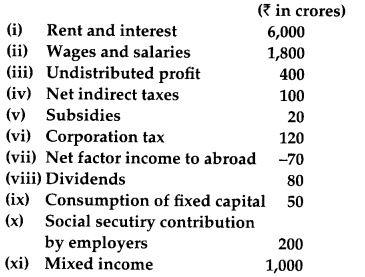
Answer:
NDP
FC
= Wages and salaries + SSC by employers + Rent and interest + Dividend + Corporation tax + Undistributed profit + Mixed income
NDP
FC
= 1800 + 200 + 6000 + 80 +120 + 400 + 1000
NDP
FC
= ₹ 9600 Crores
(a) NNP
MP
= NDP
FC
+ NFIA + NIT
NNP
MP
= ₹ 9600 + (- 70) + 100
NNP
MP
= ₹ 9630 Crores
(b) GDP
FC
= NDP
FC
+ Consumption of fixed capital
GDP
FC
= ₹ 9600 + 50
GDP
FC
= ₹ 9650 Crores
Question 24.
Explain the meaning of the following : [6]
(a) Revenue deficit
(b) Fiscal deficit
(c) Primary deficit
OR
Explain the following objectives of government budget:
(a) Allocation of resources
(b) Reducing income inequalities.
Answer:
(a) Revenue Deficit: A revenue deficit occurs when the net income generated (revenues less expenditures), falls short of the projected net income. This happens when the actual amount of revenue received and/ or the actual amount of expenditures do not correspond with budgeted revenue and expenditure figure.
(b) Fiscal Deficit: A fiscal deficit occurs when a government’s total expenditures exceed the revenue that it generates, excluding money from borrowings. Deficit differs from debt, which is an accumulation of yearly deficits.
(c) Primary Deficit: The deficit can be measured with or without including the interest paid on the debt as expenditures. The primary deficit is defined as the difference between current government’s spending on goods and services and total current revenue from all types of taxes.
OR
(a) Allocation of Resources: It is one of the important objectives of government budget. In a mixed economy, the private producers aim towards profit maximisation, while, the government aims towards welfare maximisation. The private sector always tend to divert resources towards areas of high profit, while ignoring areas of social welfare. In such a situation, the government through the budgetary policy aims to reallocate resources in accordance with the economic and social priorities of the country.
(b) Reducing Income inequalities: Government through budget makes every possible effort to reduce income inequalities. Income inequalities are so much prevalent in an economy like India. To achieve this objective, government uses fiscal instruments of taxation and subsidies. By imposing taxes on rich and giving subsidies to the poor, the government rdistributes income in favour of poorer sections of the society. Distribution of food grain through ‘fair = price shops’ to BPL (below poverty line) population is an important step in this direction. Equitable distribution of income and wealth is a sign of social justice.
Thus, government budget reduces income inequalities.